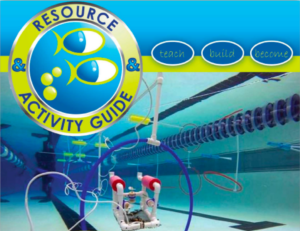

SeaPerch is an innovative underwater robotics program that teaches teachers and students to build an underwater Remotely Operated Vehicle (ROV) in either a classroom or out-of-school setting. Students build the ROV from a kit comprised of low-cost, easily accessible parts, following a curriculum that teaches science, technology, engineering and mathematics (STEM) with a marine engineering theme. Throughout the project, students will learn engineering concepts, problem solving, design skills, and teamwork. In addition, they are exposed to all the exciting careers that are possible in naval architecture and marine/ocean engineering.
Building a SeaPerch ROV teaches basic skills in ship and submarine design and encourages students to explore naval architecture and ocean engineering principles. Additionally, students gain knowledge of tool safety and technical procedures.
SeaPerch…
Students learn best by doing, and during the SeaPerch program they follow steps to completely assemble an underwater ROV. After the SeaPerch ROV is constructed, students are encouraged to test their vehicles, deploy them on missions, and compete in a competition (a SeaPerch Challenge), to take what they have learned to the next level. SeaPerch Challenges foster an end goal, reward sportsmanship, spirit and presentation skills, as well as mastery of engineering and science concepts. Events at the Challenge can include:
Winners of recognized regional or state challenges may qualify to compete in the International SeaPerch Challenge held each spring.
One of the most important aspects of SeaPerch is that it includes training for teachers. The two methods of training are online or on-site. Please submit a training request if you are interested in discussing SeaPerch training at your location.
SeaPerch has been designed to meet many of the national learning standards identified by the U.S. government. With one project, schools are able to teach many of the concepts required for their grade level using a fun, hands-on activity for students. Some of the concepts the students learn while building the SeaPerch ROV include the following:
Meets National Learning Outcomes: The SeaPerch Program meets many national learning outcomes. Visit the SeaPerch Educational Standards Mapping Page.
Encourages STEM Education: SeaPerch focuses on science, technology, engineering, and mathematics to support future scientists in these important areas and presents the possibilities of technical careers to students from all backgrounds.
Costs Per Student Are Low: The price per kit is $179, and a single kit can be used for a group of up to six students (depending on age range). Please visit the RoboNation Shop for current pricing.
Provides Web Resources & Community: The SeaPerch website provides resources, tools, information, and an active community.
The world is changing. Every job of the future will require a basic understanding of math and science. STEM (Science, Technology, Engineering, and Mathematics) education is vitally important for our students to learn and become excited about. The demand for STEM-educated workers continues to grow exponentially each year.
In 2016 the U.S. ranked 3rd in the world in the number of college graduates in STEM related programs. However, the number of U.S. STEM graduates was only 12% compared to the number of STEM graduates in China. Only 5% of science degrees are awarded in engineering, as compared with 50% in China. If it is not addressed, the expected shortage of skilled workers could decrease the nation’s global competitiveness and result in a lack of expertise in critical areas.
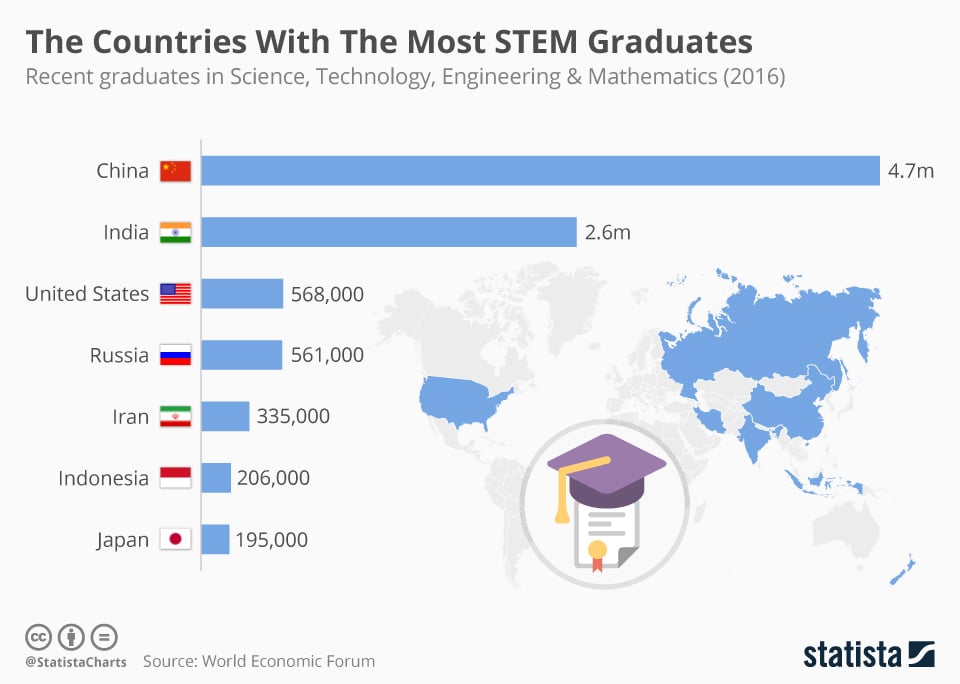
These statistics show how few students are engaged in STEM fields:
Although the numbers of students interested in and working towards degrees in STEM fields is very low in the United States, the benefits of a STEM education are high:
The STEM challenge is to increase enthusiasm for these vital fields of education, and SeaPerch is committed to doing just that through innovative, hands-on, and engaging activities and curriculum.
SeaPerch can make a huge impact on the student who may be on the fence about entering a STEM-related field, as well as on the one who has never even been exposed to STEM education. In order to take the first steps towards majoring in a STEM program in college, a student must be interested and proficient in STEM. SeaPerch is an ideal opportunity to foster a passion for STEM and teach important concepts and standards.
Inspiration, discovery, and innovation are the hallmarks of the U.S. Navy’s Research Enterprise. Maintaining a technological edge requires a dynamic portfolio of scientific research and technology development, a culture of innovation, and the capacity to draw upon diverse ideas and approaches. Tomorrow’s scientists and engineers will be at the heart of this innovation process. Without a steady stream of civilian and enlisted scientists and engineers, the Navy’s ability to maintain its science and technology superiority will falter over time. Consequently, increasing the STEM pipeline has become a critical priority for the Navy to tackle the challenges of the future.
By offering a broad range of STEM education and outreach programs, the Navy seeks to address the national crisis of decreasing college enrollments and careers in science and engineering. Through programs like SeaPerch, the goal is to engage and inspire young people by exposing them to exciting, hands-on, and mentor-based programs that build science, engineering and technology skills, while at the same time fostering self-confidence and life skills.
Educators are Able to Control Costs
Among the virtues of the SeaPerch program is the available leverage to spend as little or as much as you want. Some teachers/leaders borrow tools from school shops or parents for the construction. Some teachers/leaders reuse every part from year to year. The program lets teachers be creative and figure out how SeaPerch best fits into their classroom or program.
Parts are Inexpensive, Easy to Find & Replace
SeaPerch uses the low cost, good quality, and easily accessible parts that are easy to find and replace. Some replacement parts are available on the website at a low cost.
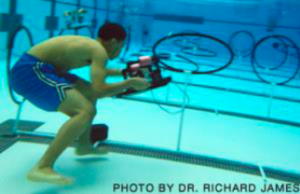
Who sponsors the program?
The SeaPerch program is generously supported by the Office of Naval Research and multiple other sponsors. For a full list of current sponsors, please visit the the Sponsors & Partners page.
Who manages the program?
The SeaPerch program is managed by RoboNation, Inc., an independent, tax exempt, 501(c)3 nonprofit with a mission to provide a pathway of hands-on educational experiences that empower students to find innovative solutions to global challenges. SeaPerch is the entry point for this pathway of programs. Visit RoboNation’s website to learn more.
How do I get kits?
All kits must be ordered online at the RoboNation Shop. We do not accept telephone, fax or email orders.
Can I buy just one kit?
Yes. Just visit the RoboNation Shop and you will be on your way! Consider whether you need to purchase a tool kit if you don’t have the tools – a list of them can be viewed from the order page.
What age group is SeaPerch appropriate for?
Any age from 5th grade through college freshmen can benefit from the program, as it is easily scalable for those ages depending on how you wish to use it.
The tools and supplies that are used during a build (drills, soldering irons, PVC pipe cutters, etc.) require manual dexterity and good hand-eye coordination for effective and safe use.
Using the kits and tools with younger students would require some modification as well as additional supervision. Suggestions include, at a minimum:
As you make the decision as to whether SeaPerch is right for your students, please refer to the Build Manual as well as the training videos on our website to get a better idea of what your kids would be doing during their build.
These are recommendations as schools/clubs/organizations are ultimately responsible for their programs and for the safety of their participants.
Who can build a SeaPerch?
Families, in-school programs, after school clubs, private clubs, and individuals of all ages and interests have built the SeaPerch ROV. Just about any group of upper elementary, middle, high school, or college students gathered with an interest in STEM can participate in SeaPerch!
How long does the build take?
SeaPerch is scalable to meet the desired needs and learning outcomes. The actual build process takes between four and eight hours depending on the skill level of the individual or group building the ROV. When the build process is incorporated into a curriculum it is usually spread over a semester and science and engineering lessons are taught in conjunction with the build. It’s all up to you and what concepts/outcomes you want to teach and achieve with the SeaPerch and your students.
How many kits are required for my group of students?
One SeaPerch Kit is recommended for each group of 4-6 elementary level students and one kit for each group of 2-4 middle or high school level students.
Do I need tools?
There is a tool kit that can be ordered via the website which provides everything needed to build a SeaPerch. Tools can be shared by students and reused yearly. Personal tools may also be used.
Is training available?
Our Build Manual may be all you need to get started as it is designed with the needs of new SeaPerch users in mind. The manual includes easy to follow step-by-step instructions and is supplemented with detailed images, videos, illustrations and helpful tips to guide you through the process. Additionally, we have online training videos that can be viewed at any time and stopped and started as needed. Please submit a training request if you are interested in discussing SeaPerch training at your location.
What if we don’t have a pool?
Many local hotels, YMCAs, community centers, colleges, universities and even retirement communities may allow access to their facilities, once the SeaPerch program and its purpose are explained. If all else fails, an above-ground pool, large tub, or other tank can be used. The minimum recommended size is 4′ x 4’ (18” deep).
What does it cost?
The SeaPerch Kit (including battery and charger) costs $179. A tool kit that can be reused year after year costs $249. There are also special parts and replacement parts available on the website for various other needs. For current prices, please visit the RoboNation Shop.
What do we need to make a successful program?
A committed champion willing to advocate for the program! The more people that can provide support for the program, the better. It is always helpful to have a larger group of teachers working together, as well as an administration willing to provide support. If possible, a university, college, or community college partner, local industry support, community volunteers/mentors, and/or tech support can all help your program reach great heights!
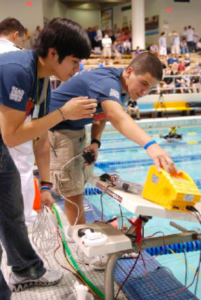
This guide contains information on everything needed to start a SeaPerch program, from lists of necessary materials to competition framework, to information about building the ROVs. Additional information can be found on this website.
SeaPerch embraces all new groups and regions that wish to become involved. No matter how small your group might be, you can impact students for lifelong learning through the SeaPerch program.
Since 2011, students in all 50 United States and in over 35 countries have participated in the SeaPerch program. It is estimated that over 250,000 students engage in the program annually. Program growth is attributed to focused local outreach and relationship development regional and national stakeholder engagement, and inter- and intra-community collaboration.
In order to make SeaPerch run smoothly and successfully for your school or organization, you need a committed champion who is willing to advocate for the program and its impact for students. This person can be a parent, teacher, administrator, local industry or university partner, or anyone else who is able to promote the program and its benefits while helping students succeed. A champion should be able to support the students from beginning to end, including the build, testing, and competitions. They should also be the one to maintain contact with other regional and/or state teams, and the SeaPerch website.
Any age from 5th grade through college freshmen can benefit from the program, as it’s easily scalable for those ages depending on the intended goals. When deciding whether SeaPerch is the right program, refer to the Build Manual as well as the training videos on the SeaPerch website to get a better idea of what your students will be doing during the build.
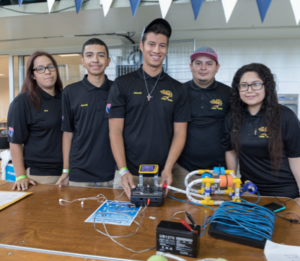
There are many things to consider when starting a SeaPerch program for your school or organization. What materials are needed? How many students can work on one ROV? How will I (the teacher/leader) learn how to build the robot in order to teach my students?
All the necessary information for starting a SeaPerch program build can be found in this manual. Additional information, including build videos and connection links, can be found on the SeaPerch main website, https://www.seaperch.org
SeaPerch is appropriate for students from fifth grade through their freshman year in college. In general, students should have at least a fifth grade understanding of science and mathematics. Beginning-level students will learn a great deal while building the basic design. As they use and practice with their ROV in the water, they will also begin to learn the connections of the build to the ROV’s maneuverability and speed. More advanced students will be able to integrate additional physics and engineering concepts into their designs and competition strategies.
In order to start a SeaPerch program, at least one teacher/leader should have the knowledge and ability to support a build after viewing the supporting materials provided here and on the website, including build videos.
SeaPerch kits are available online at a cost of $179.00 per kit. One SeaPerch Kit is recommended for each group of 4-6 elementary level students or 2-4 middle or high school level students. Additionally, one Tool Kit is recommended for every 5 individual SeaPerch kits and are available for sale for $249 each. To check current pricing and make purchases, please visit https://shop.robonation.org/collections/seaperch.
Many of the materials needed to build a SeaPerch ROV can be found in a parent’s toolbox, or a school’s wood or theater shop. Also, most tools can be purchased inexpensively and reused for many years.
Below is a list of recommended tools:
A single teacher or leader, though vital, is not enough to ensure the success of a SeaPerch program. Mentors and volunteers play a critical part in the building and testing process, as well as the competition. Their encouragement of students is so important to the success of the program. Reach out to parents and community members – often they will be more than happy to mentor students and help during the build. If there is a local college, students (and sometimes even professors based on availability) make excellent mentors.
If you are holding a local SeaPerch competition, many volunteers will be needed to ensure the competition runs smoothly. Volunteers can help set up the competition area and challenges beforehand. During the actual competition, volunteers are needed in registration, lane judging, a swimmer to reset challenges or retrieve lost parts, people to direct participants and spectators, etc. Finding volunteers to help might sound like a challenge, but it can be easy. Finding the right people who can support and back the program will allow your school or organization SeaPerch program to run smoothly and can provide the most benefit for your students. Below are some tips to help find volunteers:
For some schools and organizations, access to water may not be a problem. However, if your school or organization does not own a pool, there are several things you can do:
Be sure to always call ahead of time and make sure that the water resource you are planning to use is accessible and that you are permitted to use it.
SeaPerch works best when students are encouraged to cooperate and work together in teams. There is a great deal of material to be learned in order to complete a build. When students each choose an area to study more fully, they can share their knowledge with the team.
Any size of group can work to build a SeaPerch, from a single student to a large group. However, the following list of recommended group sizes will maximize the SeaPerch experience, reducing the need for excessive kits while allowing each student to participate:
In middle and high school, we recommend that each student take a particular area of engineering and apply it to their team and their SeaPerch ROV build. They can then prepare short lessons on their particular area of expertise in order to share with their teammates. The following student “specialties” are recommended:
We also recommend a certain number of adult supervisors in order to keep the build experience flowing smoothly and to prevent safety mishaps:
SeaPerch is a program that can be used in many different venues, from public and private schools to homeschools, to clubs and extracurricular activities. Therefore, scheduling activities, lesson plans, build sessions, and quality testing/practices are up to the discretion of the teacher/program supervisor. In a school setting, lesson plans may be set up so that teachers can use one or several class periods.
You may choose to do an entire unit with SeaPerch, or you may spread it out throughout a year or semester, interspersing SeaPerch activities with other classroom lessons. In a homeschool or club setting, you may choose to only focus on the build and testing procedures to fit the available meeting times. Whichever you choose, SeaPerch is flexible enough to fit any time constraint and availability!
Example I: Embedded in a Semester of High School
Sessions during class, 1 time per week
|
Weeks 1-3 |
Underwater Oceanography |
|
Week 4 |
Buoyancy |
|
Week 5 |
Density |
|
Weeks 6-7 |
Electrical Circuitry |
|
Weeks 8-9 |
Scientific Method and Presentations |
|
Weeks 10-14 |
SeaPerch ROV Build |
|
Weeks 15-17 |
Testing/Data Collection |
|
Week 18 |
School Competition |
Example II: Club or Group Meetings
Meetings 1 time per week
|
Week 1 |
Introduction to SeaPerch |
|
Week 2 |
Exploration of Navy and underwater challenges |
|
Week 3 |
Materials and build discussion; watch beginning build videos |
|
Weeks 4 |
Building the Control Box |
|
Week 5 |
Constructing the Frame |
|
Week 6 |
Adding Motors |
|
Week 7 |
Propellers and Battery Connections |
|
Week 8 |
Adjusting Flotation and Water Testing |
Computer Access
Computer availability for all students can be helpful, especially if you plan on having the students research topics and discover answers on their own time. Some lesson plans can benefit from each team having computer access.
However, in order to complete the SeaPerch build and to compete, it is not necessary for students to have computer access. As long as a teacher or volunteer can get onto the SeaPerch website and provide necessary instructions and materials, the students can have a complete SeaPerch experience.
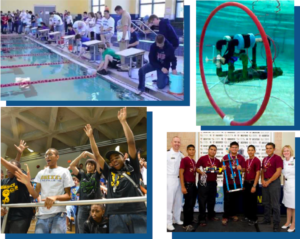
Students benefit greatly from having the opportunity to demonstrate their new knowledge and their SeaPerch ROVs. They have the chance to interact with other students interested in engineering and STEM and will gain confidence through presenting and competing. The following information will assist you in managing a local, regional, and/or state competition.
Local competitions are small events to allow for exploration and friendly competition between students from the same school, small school district, or area and provide a chance to showcase their SeaPerch ROVs and optionally compete on a small scale.
Regional competitions are larger events that welcome teams from large cities, counties, and even multiple states. Regional competitions , when properly registered, may be used as qualifiers to send teams to the annual for the International SeaPerch Challenge.
Please see specific guidance on the Competitions page for team entry rules for the International SeaPerch Challenge.
If you plan on creating a local or regional competition, contact teachers and mentors from other schools and clubs in your area to see who might be interested. If they have not yet begun a SeaPerch program in their area, mention that they can find all the necessary information on this website.
A competition, no matter how small, can really serve to pique interest in the SeaPerch program. When parents, teachers and friends see for themselves how fun and educational SeaPerch is for the students, they will be more likely to support the program and help ensure its continuation.
Challenges during an event can vary, but there are several that are consistently used. These tried-and-true events are easy to set up and prepare, and are both fun and challenging for students:
Planning a SeaPerch competition may sound challenging, but it can actually be condensed into a few simple steps:
More specific information to help you plan a successful and stress-free local or regional event can be found under “Planning an Event” in this guide.
State competitions are a terrific opportunity as regional competitions begin to grow in your area. This tiered system allows the winners of regional competitions to refine their ROV designs as well as their presentation skills, and to compete at a higher level against other champions at the state level.
Winners of registered qualifying competitions have the opportunity to attend the annual International SeaPerch Challenge. This is an exciting event for students who love the chance to travel and to meet other science- and technology-minded students from around the country.
The annual International SeaPerch Challenge serves as the culminating event for the SeaPerch season. The Challenge was first held in 2011 at Drexel University. It has grown from 40 teams to an anticipated 250 teams from more than 100 registered regional qualifiers for the 2020-2021 season. This event evolved significantly over the years and now includes multiple in-pool and out-of-pool opportunities for student teams to share their designs, experience with the engineering process, and to network with other participating teams.
Each of the competition elements aim to engage students in developing a successful ROV and to promote an understanding of how purposeful design modifications impact the performance of their ROV. In addition to the exercise of STEM skills emphasized by the competitions, teams can further develop their communication and collaboration skills through oral presentations and preparation of written documentation materials and posters. To date, teams international from Australia, the Cayman Islands, New Zealand, and the Virgin Islands have participated in the International Challenge.
More information on the current International SeaPerch Challenge can be found at the Competitions page.

Below is a timeline that may be helpful when planning a local, regional or state competition. Note that it is prudent to begin planning at least 6 months before the event is to be held.
6-9 Months Before Event:
2-3 Months Before Event:
Day of Event:
The pool area of a high school or university is often the ideal place to hold a SeaPerch event because it usually has all the resources necessary to keep the event running smoothly. The pool with lanes is the perfect place for the competitions to occur, while a diving well or small side pool can be used for last-minute testing and modifications. Spectators can use the stands to watch competitions, and classroom areas are available for presentation judging.
If this resource is not available, often local YMCA associations or gymnasiums are more than happy to accommodate a SeaPerch competition. Even small locations are suitable for regional competitions, as long as the pool can contain two or three ROVs at a time.
Regional challenges may encompass any variation of activities for the pool and presentation portions of a competition. However, it is beneficial for at least some, if not all, of the challenges to align with International SeaPerch Challenge for teams to be better prepared to compete at the international level. The description of the International SeaPerch Challenge, rubrics, and rules can be found on the SeaPerch website on the Competitions page.
Although scheduling will vary between competitions, below is a sample schedule that may help you to organize your own agenda for competition day:
6:30 A.M. – 7:30 A.M.
7:30 A.M. – 8:30 A.M.
8:30 A.M. – 12:30 P.M.
12:30 P.M. – 1:30 P.M.
1:30 P.M. – 2:00 P.M.
2:00 P.M. – 3:00 P.M.
A SeaPerch competition is an excellent opportunity to show parents, businesses, and the community the meaningful learning that students can accomplish with SeaPerch’s interactive program. Take time to plan for photo opportunities and involve your local newspapers, news agencies and local officials. By getting the word out that you are participating in a fantastic STEM initiative program, you will not only be able to grow the program, but you may also find that local businesses are willing to support your students. Below are some ways you can advertise SeaPerch:
After your competition is complete, take time to send in a brief description of the event, as well as pictures, to seaperch@robonation.org . We want to feature your competition on the SeaPerch website and acknowledge your successes!
Volunteers play a vital part in any SeaPerch competition. You may be surprised at the number of volunteers that want to help with your event! For a local, regional or state competition, you will need to enlist several different types of volunteers, listed below. The number of volunteers in each category will vary depending on the size of your event.
When searching for volunteers, consider approaching the following groups of people:
Remember to thank all volunteers for their time and efforts to make your SeaPerch competition a positive and successful event!
A triage table is a table with spare parts and tools just in case something breaks or goes missing. In a competition with lots of kids running around with robots, be sure that something will go wrong. It’s always better to be prepared rather than have to scramble for extra parts in the heat of the moment. A typical triage table might contain the following equipment and parts:
Awards are up to your discretion, but as a rule, more is better. Although there will be some teams who are clearly ahead in certain areas, all students should be congratulated and encouraged, since all students have worked hard to create and use their SeaPerch ROVs. Even the teams who do not move up in the competition will be thrilled to receive a smaller award acknowledging their efforts. Plan to celebrate the successes of all participants!
In general, awards should be given at both the middle school and the high school level. Below is a sample framework of awards:
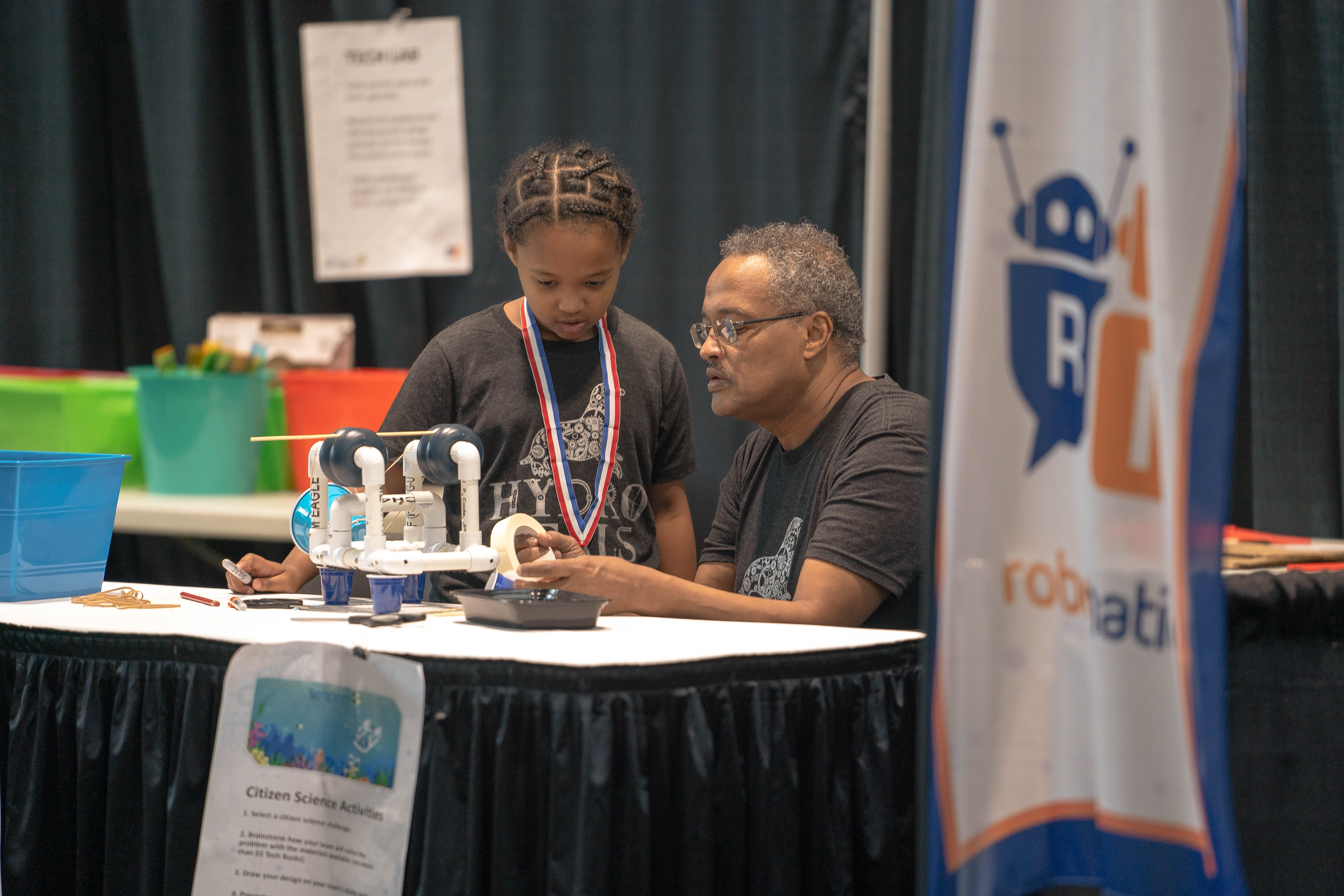
SeaPerch is more than just an opportunity for students to build a cool robot. It can be turned into an entire curriculum based on the SeaPerch ROVs. We have a collection of lesson plans, in addition to supplemental materials like PowerPoint presentations and worksheets, to help you make the most of this amazing opportunity. These materials can be found in the SeaPerch Resource Library.
Whether you want to take a single day and learn something new through one of our SeaPerch lessons, or if you wish to delve deeper and create an entire unit, we have resources you can use to enrich your students’ SeaPerch experience.
SeaPerch is committed to providing educators with the resources necessary to begin and maintain a robust program. The SeaPerch Build Manual has been mapped to Next Generation Science Standards, Common Core, and P21 standards for 5th – 12th grade.
More information can be found on the SeaPerch Educational Standards Mapping page.
Presentations
Students are encouraged to create presentations over the SeaPerch build and testing process. While the hands-on experiences are important, it is also crucial that students learn how to share those experiences concisely and clearly with others. These skills will be important as students begin preparing for college, internships, and jobs.
Engineering Notebooks
Engineering notebooks are used by engineers to document their ideas and the steps taken to solve engineering problems. They carefully and systematically track and analyze progress and results and provide a legal document that can be used as proof of invention for products they design. Engineering notebooks are sometimes referred to as an Engineer’s Notebook, Design Notebook, Laboratory Notebook, or Inventor Notebook.
The use of an engineering notebook is highly recommended throughout the SeaPerch program. The use of an engineering notebook is part of the International SeaPerch Challenge and many Regional SeaPerchChallenges. Additional information can be found on the SeaPerch Engineering Design Process page.
Students are always so excited about the SeaPerch build and the actual creation of an ROV. What they might not realize is that, during the build process, they are gaining many new abilities, from engineering to life skills such as working on a team. The SeaPerch Build Manual, found on the SeaPerch website, will show you how to help your students complete a successful, fun, and educational build. Here are some helpful resources:
One of the most exciting things about SeaPerch is that students don’t have to ascribe to a to-the-letter model. They have the freedom to add enhancements and change the design of their ROV so that it reflects their personal ideas and imaginations. SeaPerch is an opportunity to think outside the box!
Now that you’ve built a SeaPerch, it’s time to take it to the next level. Enhancing your SeaPerch can take on many different paths. Students who desire to move beyond the initial level of the SeaPerch’s capabilities may consider adding upgrades such as:
The possibilities are endless!
Hydrophone
Want to hear what is going on underwater? Build a hydrophone! How to Build a Hydrophone (COSEE TEK)
Sea Star Surface Craft
The Sea Star Surface Craft project is intended to introduce students to the basic concepts of hull design, and related concepts such as buoyancy, center of gravity, center of buoyancy, righting moment, fluid dynamics, drag, etc. It is based on the forming of a hull out of foam, allowing students to experiment with varied designs. The motor and radio control system are easily movable from one hull to another.
View the Sea Star Surface Craft construction manual (MIT Sea Grant).
Super SeaPerch
The Super SeaPerch project is intended to introduce students to the basic concepts of hull design. View the Super SeaPerch Manual (MIT Sea Grant).

SeaPerch is a perfect avenue to direct students towards degrees and careers in STEM. In the following pages, you will find resources to offer your students and help set them on the path to success!
Did your students enjoy building and using their SeaPerch ROVs? There are dozens of careers that will allow them to have that kind of fun every day. Engineers and scientists in the field of marine science and engineering face interesting challenges involving water, robots, marine life, complex electronics, water and pressure resistant housings, corrosion, video navigation, computer control problems, and flight dynamics (just like an airplane, but wet).
If your students found a certain part of the SeaPerch process particularly interesting, they may be surprised to find that there are careers that fit their interests perfectly. Below you can see different steps of the building and operating procedure, and a few careers that match up with them:
Frame Construction
Waterproofing the Motor
Building the Control Box
Choosing a Battery
Adding Ballast and Flotation
Driving theSeaPerch
Video
Building Sensors
Programming Sensors
Studying the Ocean
Improving SeaPerch Design
Adjusting the Motors
Inventing New Components
Microcontrollers
Choosing a Propeller
Water Sampling
STEM careers are among those with the highest demand in the United States. Science, technology, engineering, and mathematics careers include (but are certainly not limited to) these interesting, challenging, and in-demand jobs:
Below are some online resources for teachers and students interested in the variety of STEM careers:
Do your students like jumping right in and getting their feet wet – literally? A marine career might be the perfect choice for them. Some marine careers include marine biology, marine geology, seismology, coastal geography, physical oceanography, chemical oceanography, and ocean engineering. To check out more in-depth information about marine careers and other opportunities, visit the following links:
People trained in the field of Naval Architecture, Marine Engineering, and Ocean Engineering are always in demand. In today’s world of increasing international trade, amid growing awareness of our environment, and concern about maritime security and national defense, people with these skills are essential. They design, build, and operate vessels to transport and protect people and goods; they design all types of ocean structures. Maritime trade, national defense, environmental protection, and security are not temporary concerns, but permanent responsibilities. The demand for maritime professionals will continue to increase.
Over 95% of the world’s goods arrive at their destination by ship
RoboNation, the organization that manages the SeaPerch program, also manages or supports several other robotics programs and competitions. RoboBoat and RoboSub are natural progressions to the SeaPerch program and offer advanced competitions that will help challenge and prepare middle school through graduate level students to face real world challenges in autonomous vehicle design, fabrication, programming, and use.
STEM Education & Robotics: http://www.robonation.org/stem-education-robotics
SeaGlide: http://www.robonation.org/seaglide
RoboTour: http://www.robonation.org/robotour
RoboBoat: http://www.robonation.org/competition/roboboat
RoboSub: http://www.robonation.org/competition/robosub
Maritime RobotX Challenge: http://www.robonation.org/competition/robotx
Intelligent Ground Vehicle Competition (IGVC): http://www.robonation.org/competition/igvc
Student Unmanned Air Systems (SUAS): http://www.robonation.org/competition/suas
International Aerial Robotics Competition (IARC): http://www.robonation.org/competition/iarc